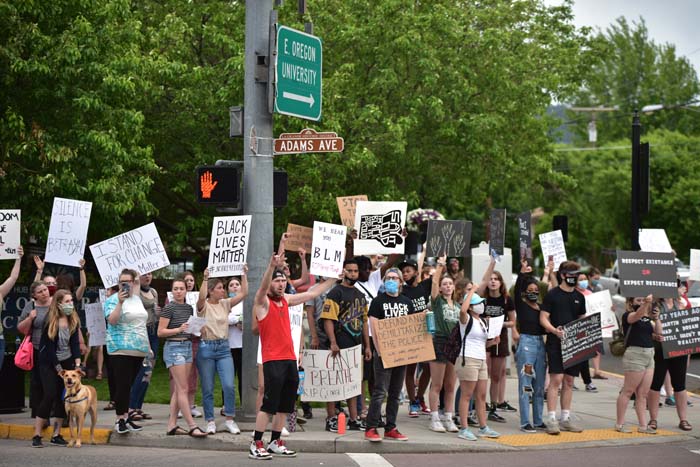The Observer’s top 10 non-COVID-19 stories
Published 5:15 am Thursday, December 31, 2020

- Hundreds of people — many La Grande residents and Eastern Oregon University students — gathered Tuesday, June 2, 2020, at La Grande City Hall for a racial equality protest. The large group lined most of the block along Adams Avenue and Fourth Street, and at one point marched to the corner of Island and Adams.
10. Animal shelter rebounds from turmoil
The Blue Mountain Humane Association in La Grande reported in 2020 it was struggling financially but moving in the right direction in the wake of a mess from the shelter’s former director.
Beverly Beach, president of the association’s board of directors, said trash throughout the building at 3212 Highway 30 and incomplete financial records were problems in the past.
Cleaning up the sections for keeping animals was the biggest and most successful project, Beach said. The room that housed adult cats had urine-soaked hay, and many of the cats were not socialized properly, she said. Now the cats seem happier and roam more freely and interact with the shelter staff more frequently.
Because of old appliances, scrap metal and trash in the back area of the shelter, Beach said, dogs were not able to run around outside. The back area of the shelter now is clean and every dog goes outside at least once a day, Beach said.
Beach said the main focus is on taking care of the animals. The shelter’s record keeping has been reinstated, and every animal is in the system now, Beach said.
The board also closed Barkin’ Basement, a thrift store that benefited the shelter, after COVID-19 hit. The store cost more to run than it was making, Beach said, and customers couldn’t come in while they were shut down, so the board decided it was best to close the store and sell off remaining items.
9. Partisanship rears head in La Grande City Council race
Partisan politics became a hot issue at an unlikely place in 2020 — the La Grande City Council campaign trail.
Three city council positions and the mayoral position were up for election in November. Elections for La Grande City Council positions are normally free of partisan politics because the races are nonpartisan.
However, a member of the local Republican Party launched a political attack on city council candidates based upon their registration as Democrats. The critic made cutting comments in broad strokes, insinuating the Democrats would support violent riots and looting and defunding the La Grande Police Department.
Alex McHaddad, director of the Blue Mountain Translator District and a Republican, was running for major of La Grande and said council candidates should declare their party affiliation because it provides voters with more information about them. Mayor Steve Clements disagreed, stating he was opposed to political party partisanship on the city council front. He said this could lead to people being unfairly labeled.
“You don’t judge a book by its cover and a label does not make a person,” Clements told The Observer in October before winning reelection.
8. District attorney sidelines judge
Circuit Judge Wes Williams has not presided over a criminal case in Union County since early April, after District Attorney Kelsie McDaniel filed a motion to disqualify him from hearing cases.
Oregon law allows attorneys to disqualify a judge from presiding over a case without submitting a reason. McDaniel, however, submitted a 31-page memorandum arguing the state cannot receive a fair trial under Williams.
McDaniel tried to sideline Williams with one overarching motion. Oregon law, however, requires a motion to disqualify in each case a judge might handle and before there are substantial rulings. Thus, McDaniel continues to file the motion and the memorandum.
The 10th Judicial District, which encompasses the circuit courts of Union and Wallowa counties, has only two judges — Williams and Thomas B. Powers, the presiding judge. Michelle Leonard, trial court administrator for the 10th Judicial District, said in the spring the motion has not affected case scheduling. With COVID-19 restrictions in place, the courthouse limited cases to one courtroom and one judge per week.
McDaniel’s actions prompted a few locals to express their concerns in letters to the editor.
7. Eastern Oregon University removes controversial name from library
The Eastern Oregon University Board of Trustees in November 2020 finally voted to rid the campus library of its controversial name.
The library’s name was a point of contention for years. The building’s original namesake, former Oregon Gov. Walter Pierce endorsed eugenics, garnered political support from the Ku Klux Klan and made Klan ideology into Oregon policy. EOU later renamed it the Pierce Library for Walter Pierce and his wife, Cornelia Marvin Pierce, and she held views similar to her husband.
That contention picked up speed in 2017, when Eastern’s faculty senate passed a resolution affirming their desire to see the library renamed. Three years later, on Nov. 12, 2020, EOU’s Board of Trustees voted unanimously to strip the library of the Pierce name, but not before the movement to do so became caught up in wider concerns about “erasing history.”
Eastern is taking steps to prevent the library’s legacy, good or bad, from being lost. The university plans to install a display explaining the former namesake as well as the reason for the change.
For now, the library has been simply renamed the “EOU Library.” University officials said it would be some time before changes were fully implemented.
6. Team seeks to solve old homicide
Melinda Jederberg of La Grande set out on a mission to identify the young woman someone buried in a shallow grave near Elgin more than 40 years ago.
Hunters in late August 1978 found the human remains near a log on Finley Creek some 18 miles north of La Grande. The Observer covered the story at the time.
Jederberg, who earned a bachelor’s degree in criminology in 2007 from Eastern Oregon University, La Grande, said she came across The Doe Network in 2019, a website devoted to cold cases of missing and unidentified people, and found the unsolved Finley Creek case.
She set up the Facebook page Finley Creek Jane Doe — Elgin, OR to raise awareness about the case and maybe gather clues. Others found the page, and soon Jederberg had a cadre in the U.S. working to identify the woman. The team obtained the full Oregon State Police report on the case, complete with the medical examiner photos.
A team member involved the help of Anthony Redgrave of Massachusetts. He recreates faces in a process he described as “forensic art.” Redgrave in May used the photographs to give the Finely Creek Jan Doe a face.
Jederberg and the team continue to provide case updates on Facebook. The team is receiving assistance from Dr. Veronica Vance, forensic anthropologist for the Oregon State Medical Examiner’s Office, to try to determine if certain missing women are potential matches for Jane Doe.
5. Community loses beloved member
La Grande lost a beloved and revered community volunteer on May 7, 2020, when Doug Trice, 68, died of natural causes at his La Grande residence.
Trice was a hall of fame athlete at La Grande High School and Western Oregon University, but he is best remembered as an award-winning Special Olympics coach.
“He was a great humanitarian and an amazing ambassador for this community,” said Joe Brogdon, a retired La Grande High School educator and an assistant Eastern Oregon University track coach.
Trice received much recognition for his Special Olympics work. In 2007 he was named an assistant coach for Team USA at the World Games in Shanghai, China. That same year he received a Governor’s Gold Award from Oregon Gov. Ted Kulongoski for his work in Special Olympics. Four years later, Trice was selected as a Special Olympics coach for Team USA in Athens, Greece.
The La Grande City Council, on Sept. 7, 2020, voted to rename Community Field at Pioneer Park in honor of Trice. The name change took effect immediately.
Trice also worked closely with other youth programs in the community, stepping forward whenever youths needed help.
“He never said no to anybody. He set a high standard. He was an amazing volunteer,” said Lin Casciato of La Grande, a close friend. “The guy was just an amazing human being.”
4. Locals help with Western Oregon wildfires
Devastating wildfires broke out on Sept. 7, 2020, in Western Oregon and firefighters and volunteers from Union County immediately extended hands of assistance.
Eight local firefighters on Sept. 9 went to Western Oregon — four from the North Powder Rural Fire Department and two each from the La Grande Rural and the Imbler Rural fire departments. They began their Western Oregon firefighting efforts in Clackamas County.
The La Grande Fire Department sent two firefighters to the Eugene area on Sept. 13. The 10 Union County firefighters went with vehicles from their departments and were part of a task force that included firefighters from Umatilla County.
The local agencies sent the firefighters and vehicles at the request of the state fire marshal.
Other locals reached out in a big way, providing assistance to victims of the fires in the form of clothing and supplies. Members of Imbler High School’s National Honor Society, Future Business Leaders of America and FFA chapter on Sept. 18, 2020, delivered 1,200 items for fire victims to La Grande, where La Grande Strong and Emergency Equipment Solutions worked together to ship them to Western Oregon.
3. The race for Union County sheriff
Six months before Union County voters elected their next sheriff, four men were in the race to lead the office. But only one name made it on the ballot.
The race began with four-term incumbent Boyd Rasmussen, probation officer Bill Miller, deputy Cody Bowen, and 21-year military veteran Shane Rollins all vying for the position.
The May primary derailed Rollins’ and Miller’s chances to appear on the ballot, leaving only the long-time sheriff and Bowen, the school resource officer, though that changed in the summer.
Rasmussen dropped out of the race in August. An Oregon Department of Justice investigation had dogged his campaign since its inception. Then the Oregon Department of Public Safety Standards and Training announced an investigation into Rasmussen’s “moral fitness” just days after he withdrew from the race.
Rasmussen didn’t drop out before the rhetoric around the race became heated, with he and Bowen regularly trading public blows.
That left only Bowen’s name on the ballot, though Miller proceeded to mount a substantial write-in campaign. There were 4,832 write-in votes on Nov. 3, but Bowen’s 8,968 were more than enough to cement him as sheriff-elect for Union County.
2. Union County Sheriff Boyd Rasmussen under the microscope
Boyd Rasmussen was seeking a fifth term as Union County sheriff amid rumors he was under investigation. The rumors ended in late April, when Cody Bowen, then deputy and now sheriff-elect, confirmed the Oregon Department of Justice was investigating Rasmussen.
Days later, The Observer obtained a copy of the DOJ’s eight-page summary of its investigation that outlined accusations against Rasmussen, including that he pocketed more than $7,000 from the city of Elgin for police services in violation of state law. But any misconduct, according to the report, was beyond the statute of limitations.
Rasmussen defended the deal with Elgin.
“There was no ill intent,” Rasmussen said. “It was a simple transition with the city of Elgin. Did I knowingly go out there and violate the law? Hell no.”
Rasmussen, however, became the subject of an Oregon Department of Public Safety Standards and Training hearing regarding accusations he violated ethics for years while in office. The Observer used Oregon Public Records laws to obtain the two letters making the accusations plus a copy of the justice department’s full report. The newspaper also interviewed current and former Union County Sheriff’s Office employees concerning Rasmussen and their numerous allegations, which ranged from improper use of county money to buy snowmobiles to the contract with Elgin.
Rasmussen in response to the accusations only stated The Observer “received much false and misleading information.” But he withdrew from the race for sheriff, and DPSST launched an investigation into his moral fitness.
1. Locals dive in — and react — to Black Lives Matter movement
As the rest of the nation protested and mourned the death of George Floyd, 11-year-old Miri Koltuv of La Grande wanted to bring home the fight for racial equality.
She organized a protest the morning of May 30 in front of La Grande City Hall at Adams Avenue and Fourth Street that drew about 20 participants.
“It is not as big of an issue here as in New York, because there is not as many people of color here,” Koltuv said, “but there are still people here and it is important that we let them know we see them and are protesting for them.”
Those voices crew exponentially louder when hundreds gathered June 2 outside city hall for a follow-up protest for racial equality. The participants were local and of multiple age groups and ethnicities. They lined the city hall block, many carrying signs and chanting the refrains that have rung across the country, including “I can’t breathe” and “Black lives matter.”
They also yelled “We all bleed red,” “We are one” and other messages. They also marched to the corner of Island and Adams avenues before returning to city hall, where drivers largely supported the rally and honked their vehicle horns.
“We want to see everyone feels loved, everyone feels accepted, regardless of their race, color, gender,” Eastern Oregon University student Josie Shea said. “We’re here to make a change.”
A group of armed residents arrived at Cook Memorial Library, diagonal to city hall, and expressed concerns related to rumors that radicals or members of the group Antifa possibly infiltrated the protest. They said they did not want to see the protest turned to riot, as happened in Portland and other major cities. Eventually, members from both sides crossed to the other to engage in conversation and diffuse much of the angst.
EOU student Kelsey Ranger said: “Let’s hope this moment is a catalyst for change. This has been a long time coming.”
Some 200 Black Lives Matter protesters on June 5 held forth during a thunderstorm in Enterprise at the Wallowa County Courthouse grounds.
“About 98% of the people were from Wallowa County,” said protest organizer Gianna Espinoza, who lives in Enterprise. “There were a couple of tourists who stopped by and joined us, plus two people from La Grande and probably some summer residents, but it was pretty much all locals.”
About 30 residents — among them half a dozen armed with assault rifles and sidearms — were concerned with social media postings claiming busloads of Portland Antifa were on their way to damage stores and windows.
“There are officers posted in Wallowa and Lostine and Enterprise and Joseph watching,” Enterprise Police Chief Joel Fish said. “So far, we haven’t heard a thing.”
The social media predictions of mayhem never materialized.
And while the protests subsided, the Black Live Matter movement continues to have a local presence.
Maria Carmichael of La Grande organized a fundraiser in August for a billboard displaying “Black Lives Matter” in her hometown. By early September, the billboard was on display on the eastbound side of Interstate 84 near exit 261.
“I hope the people who look at that sign and get angry about it, at least some of them will stop and consider why it makes them so angry and lead them to educate themselves,” Carmichael said, “and if not, at least it sparks the conversation.”
The sign did, and it also sparked pushback. Other locals put up competing billboards in La Grande, one displaying “Trump 2020” and another proclaiming “All Lives Matter.”









